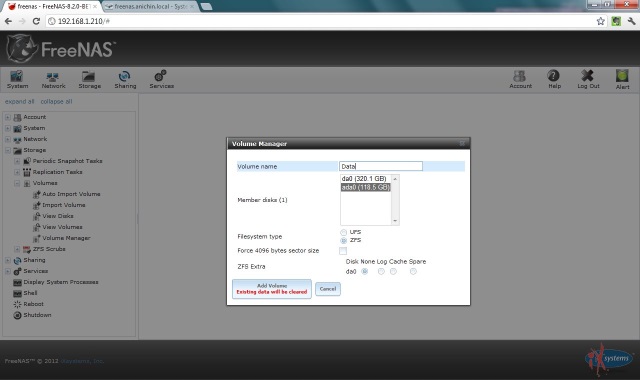
qwertymodo's Hard Drive Burn-in Testing - A guide for more thorough testing of your disks than that which is contained in DrKK's guide above. DrKK's will guide you through the basics of setting up a FreeNAS server. From hardware testing to system reporting, to scheduling those all important scrubs and S.M.A.R.T. DrKK's guide to basic configeration of a new FreeNAS server. Especially helpful for new and prospective users, Cyberjock's guide contains information that every users should know like the back of their hand. That way there's less room for misunderstandings. Getting help with your problem is a lot easier when everyone uses the correct terminology. jgreco's Terminology and Abbreviations Primer.
FREENAS VOLUME MANAGER MANUAL
The manual is always a good place to start when you have a question that needs answering. Visit our sister subreddit: r/TrueNAS Helpful Links



Otherwise FreeNas will never see the new drive.FreeNAS is now TrueNAS CORE: Announcement It will be necessary to recreate the new virtual drive in the PERC BIOS.

Frankly, this NAS drive is going to be as a Backup storage unit and is not as critical as using it as a storage drive for a VM Server like Hyper-V or ESXi, therefore additional redundancy is not an issue for us. Before you say it, we know that a ZFS2 or ZFS3 provide better redundancy. So we opted to let FreeNas do the work instead.įreeNas has the ability to create RAID arrays in the form of ZFS Volumes.
FREENAS VOLUME MANAGER DRIVERS
We found that there other drivers available for FreeBSD that some folks have had success with but we still came across some comments that made us question them. Sometimes the system would boot, other times it would just hang during start up. Mostly because the drivers for this device provided in FreeNas are not very stable. We quickly found that using the factory PERC (PowerEdge RAID Controller) to create a RAID 5 Array was not going to work. The goals we wanted to accomplish were creating a RAID5 array of 8 (7+1 Hot Spare) 1TB hard drives and then wanted to connect this FreeNas volume through and iSCSI channel to a file server that will present the NAS as a shared folder all of our servers could use. There were some stumbling blocks on the way though. So you have an old Dell PowerEdge 2900 Server laying around with a few hard drives and your thinking I would really like to use this equipment as a NAS drive.


 0 kommentar(er)
0 kommentar(er)
